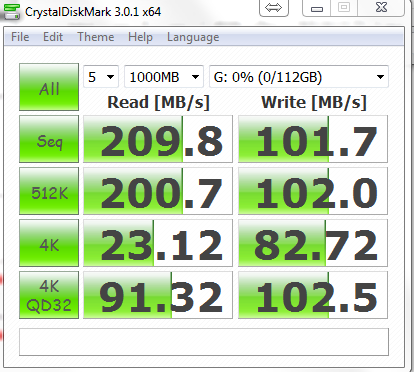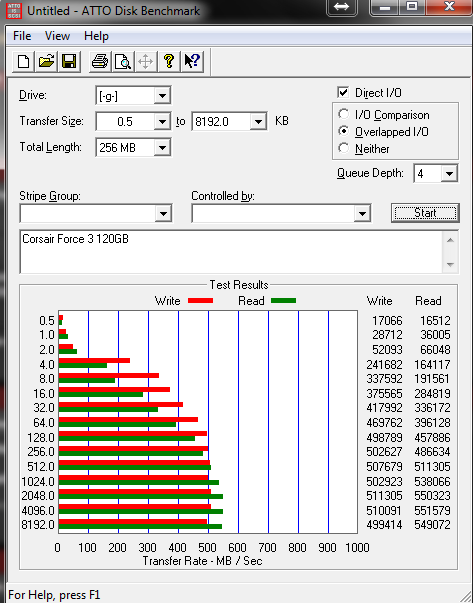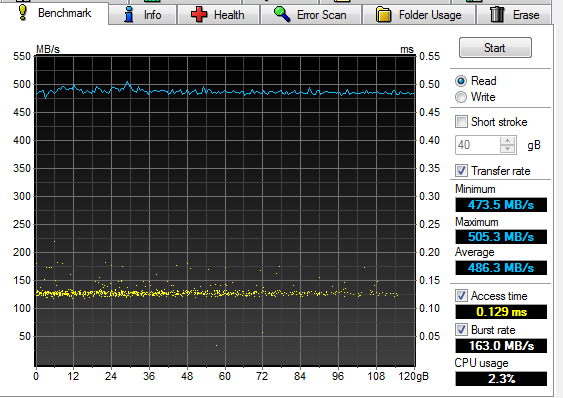The Corsair Force Series 3 120GB drive combines a Sandforce 2200 series controller alongside asynchronous NAND memory to provide a lot of performance at a relatively low cost. It should be noted that the earlier drives, specifically those starting with serial numbers before 1123 were recalled on June 7, 2011 due to firmware issues. Unfortunately, SSDs from all manufacturers, including Intel, have still seen some firmware issues and there may still be some lingering issues with the Force 3 series. Frankly though, every manufacturer has seen issues so the takeaway here is, buy a SSD, and have network backup. Luckily readers of this site tend to have lots of network attached storage for backups so recovering from a SSD is a trivial affair. After reviewing the Corsair Performance 3 (P3-128) 128GB drive based on the Marvell controller, I decided to purchase a Force 3 120GB drive to compare.
The Force Series 3 120GB drive uses a SandForce SF-2281 controller which is capable of up to 85K IOPS and 550MB/s read, 510MB/s write speeds. Those read/ write speeds should be looked at somewhat skeptically since real-world speeds are likely to be much slower. SandForce drives utilize a compression/ encryption algorithm to minimize physical writes thereby increasing speeds. One other thing that should stand out is that the drive uses asynchronous NAND which is a bit slower in real world tests than synchronous NAND. The tradeoff is slightly lower speeds for slightly lower prices. Corsair also bundles the SF-2281 with synchronous NAND in its Force GT lineup.
Test Configuration
I am using a Sandy Bridge test bed here as the Cougar Point SATA 6.0gbps controller is perhaps the best 6.0gbps SATA controller on the market at the moment.
- CPU: Intel Core i5-2500K
- Motherboard: ASUS P8H67-M EVO
- Memory: 8GB 1600MHz CL9 DDR3 (4x2GB)
- OS Drive: OCZ Agility 2 120GB
- Additional Drives: Corsair Force 3 120GB
- Additional NICs: Intel Gigabit CT PCIe x1 network adapter
- Enclosure: Supermicro SC731i-300B
- Power Supply: Supermicro 300w (included in the SC731i-300B)
One important note here is that the Force 3 120GB benchmarks were much lower when I tried the drive under IDE mode. As with any modern SSD, set the controller to AHCI mode or RAID mode for best performance. Also, installing the Intel RST 10.xx series drivers over the default Windows 7 drivers showed a nice performance gain.
The Tests
It is important, especially with SSDs not to take a single test result at face value. One should look at a few different tests to get an idea of how the drives perform in different scenarios. To this end, AS SSD benchmark, CrystalDiskMark, ATTO and HD Tune Pro all show different facets of performance.
AS SSD Benchmark
AS SSD is a solid benchmark that does not write compressible data to drives. The result is perhaps one of the best workstation SSD benchmarks available today.

Here one can note I consistently had issues getting the read access times under AS SSD. Although the 4K speeds are great, one can see that the sequential speeds are nowhere near 500MB/s. This is one test where the asynchronous NAND really hurts performance.
CrystalDiskMark
CrystalDiskMark is another benchmark which gives non-compressible read/write numbers.

CrystalDiskMark is another benchmark where synchronous NAND is much better for sequential performance. I was quite shocked to see the speeds I did, but they look about right when looking at other benchmarks on the web. I had the opportunity to write a 60GB Steam folder off a RAID array capable of transferring the folder at an average of over 450MB/s to the Force Series 3 drive. I saw ~89MB/s average to the Force 3 so these numbers look OK from a real-world gut-check perspective also.
ATTO Benchmark
ATTO shows some fairly strong performance, I will note that the value of the ATTO benchmark is really to show the best-case scenario. ATTO is known to write highly compressible data to drives, which inflates speeds of controllers that compress data like SandForce does prior to writing.

Here one can see the 550MB/s read, 510MB/s write speeds verified. ATTO’s benchmark is notorious for using compressed data so this is more like a max theoretical exercise that is widely used by SandForce drive manufacturers.
HD Tune Pro
HD Tune and its Pro version have been longstanding disk drive benchmarks. I started including the basic benchmark in reviews since I do test a mix of hard drives and solid state drives.

Here one can see the sequential transfer rates are clearly using fairly incompressible data. Unlike hard drives where sequential transfer speeds decrease from the outer to inner tracks, solid state drives to not exhibit this behavior.
Conclusion
Overall, theCorsair Force 3 drive is fast, and can put out significant speeds with compressible data. The 4K random speeds are pretty decent but I have to pause here. On one hand, the asynchronous NAND is a bit disappointing in sequential speeds with incompressible data. On the other hand, the drives are a bit less expensive (about 10%) than synchronous NAND based drives. Realistically, if one is not running benchmarks, it is pretty hard to tell the difference. Hopefully I can do a Force 3 v. P3-128 comparison soon.



